As the heavy rainy season causes a drop in table grape harvest volumes in Brazil, the attention of the industry is focused on their big local market. Edis Matsumoto, from Brazil's table grape producers' cooperative COANA, says, "Until now we had few rains compared with last year, so the production comes very nice with good quality. As this period is frequently rainy, our vines with sensitive grapes are all covered. Right now we are cropping and selling to the very strong local market."
 Edis Matsumoto, from Brazil's table grape producers' cooperative COANA.
Edis Matsumoto, from Brazil's table grape producers' cooperative COANA.
He says last year they had mixed results due to the ever-changing weather in Brazil. "In general the weather was very nice at the end of last year, but in terms of production, we had yield problems in the fields as a consequence of the bad weather of the first semester. But, from December until April, we have a higher risk of rain. Depending on the year, this volume of rain can vary from 200 mm to 900 mm. The market was very strong with high prices in both the local and export markets," states Matsumoto.

The local Brazilian market is huge, with a population of over 215 million, with Coana selling 6,000 tons locally each year alone. He says due to Brazil's unique climate table grape growers are able to grow and harvest grapes all year round. "We can produce every month of the year. Normally in the first semester, the volumes produced in our region start to increase in February and go till April. In the second semester, the crop is concentrated from September until November. During other months the production decreases a little bit and the sales are directed to the internal market."

Brazil sends grapes to their key markets until South Africa and Chile's volume arrives from around the end of November each year, concludes Matsumoto. "Traditionally we send grapes to the UK, Continental Europe, and the USA, almost one-third to each one, starting in mid-September until the end of November, before arrivals from South Africa and Chile."
For more information:
Edis Matsumoto
Coana
Tel: +55 (87) 98835-1907
Email: [email protected]
www.coanabr.com.br










